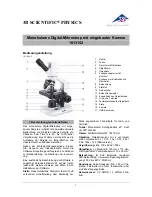
OKO-1-BA-en-2111
14
5 Operation
5.1 First steps
The first thing to do is to connect the
power supply by means of a mains plug.
The
light intensity control (dimmer)
should first be set to a
low level
, so that the eyes
are not immediately exposed to too much light when looking into the eyepieces for the
first time. Now the
illumination
can be
switched on
via the
main switch.
The next step is to
place an object or slide
with specimen on the stage. The cover
glass (if used) must face upwards for this.
In order to move the point of the object to be observed into the beam path, the
adjustment wheels on the right of the mechanical stage must be operated accordingly
(
see illustration
).















































